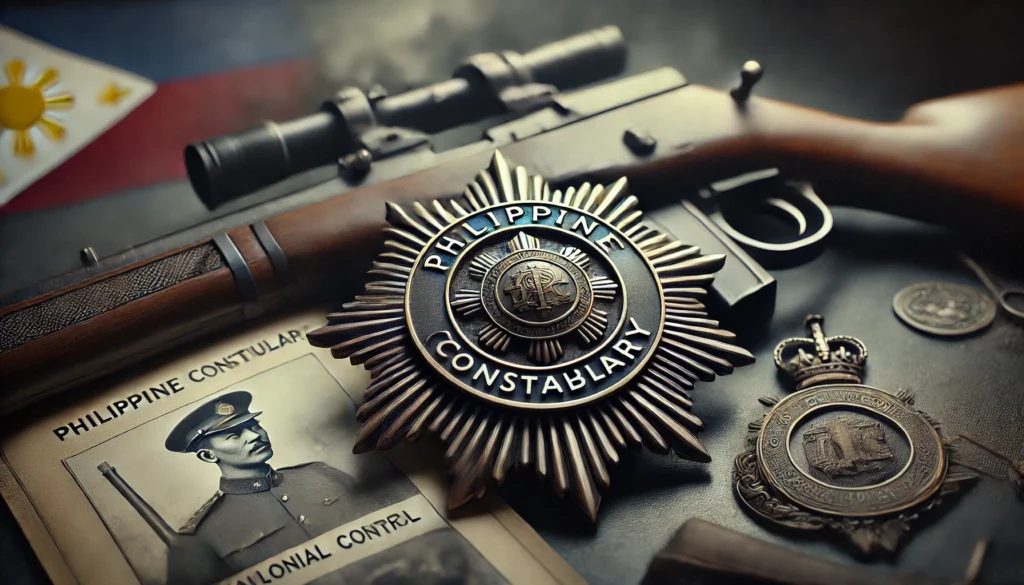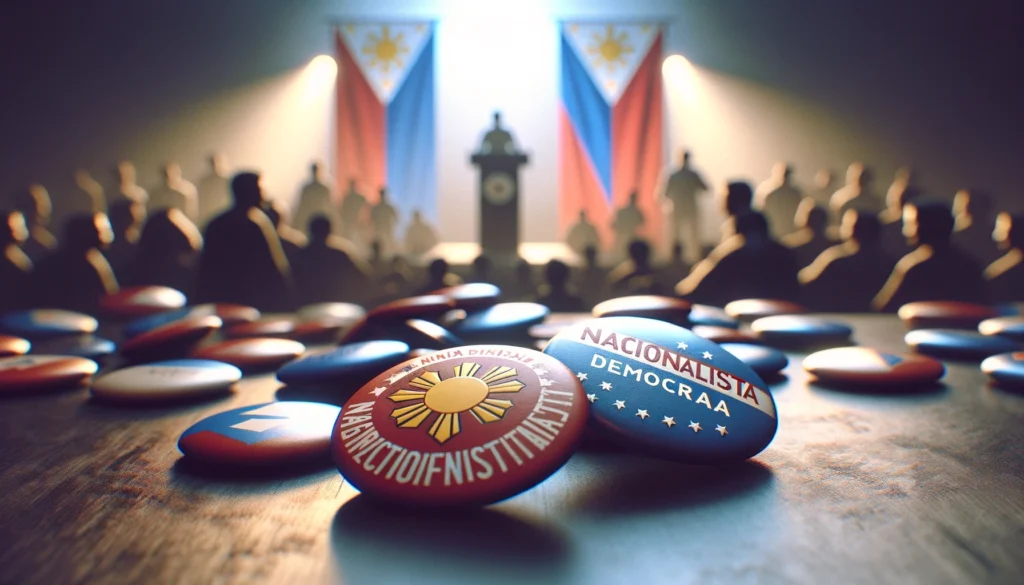The Philippine Constabulary, a paramilitary police force, was established on August 8, 1901, during the American colonial period in the Philippines. It was created by the United States Philippine Commission, led by William Howard Taft, who would later become the 27th President of the United States. The primary purpose of this organization was to maintain peace and order throughout the archipelago, which was still reeling from the aftermath of the Philippine-American War.
Initial Structure and Leadership
The initial structure of the Philippine Constabulary was modeled after the British colonial police forces in India and other parts of Asia. Captain Henry T. Allen, a United States Army officer, was appointed as the first Chief of the Constabulary. Under his leadership, the force was organized into companies, with each company responsible for maintaining order in a specific province or region.
Early Challenges and Expansion
In its early years, the Philippine Constabulary faced numerous challenges. The force had to contend with ongoing insurgencies, particularly in the southern islands of Mindanao and Sulu. Despite these difficulties, the Constabulary expanded rapidly. By 1907, it had grown to a force of about 7,000 men, organized into 50 companies spread across the archipelago.
Role and Functions
Maintaining Law and Order
The primary function of the Philippine Constabulary was to maintain law and order throughout the Philippines. This included regular policing duties, such as crime prevention, investigation, and apprehension of criminals. The Constabulary was often the only law enforcement presence in remote areas of the country, making it a crucial element in the American colonial administration’s efforts to establish control over the entire archipelago.
Counter-Insurgency Operations
Beyond routine policing, the Constabulary played a significant role in counter-insurgency operations. It was instrumental in suppressing various rebellions and armed resistance movements against American rule. Notable among these were the campaigns against the Moro resistance in Mindanao and the suppression of peasant revolts in Luzon and the Visayas.
Intelligence Gathering
The Philippine Constabulary also served as an intelligence-gathering agency for the colonial government. Its members, being largely Filipino, were able to penetrate local communities and gather information on potential threats to colonial rule. This intelligence function was crucial in helping the American authorities maintain their grip on power in the face of growing nationalist sentiments.
Training and Development
The Philippine Constabulary Academy
To ensure a steady supply of well-trained officers, the Philippine Constabulary Academy was established in 1907 in Baguio City. This institution, which later evolved into the Philippine Military Academy, provided rigorous training in law enforcement, military tactics, and colonial administration. The academy played a crucial role in professionalizing the Constabulary and creating a corps of Filipino officers loyal to the colonial government.
American Influence on Training
The training of the Philippine Constabulary was heavily influenced by American military and law enforcement practices. American officers served as instructors and mentors, imparting not only technical skills but also American values and ideals. This influence would have lasting effects on the development of law enforcement in the Philippines, even after independence.
Specialization and Modernization
As the Constabulary evolved, it developed specialized units to address specific challenges. These included mounted units for patrolling remote areas, marine units for coastal and riverine operations, and later, aviation units. The force also kept pace with technological advancements, adopting modern weaponry and communication systems as they became available.
Impact on Philippine Society
Instrument of Colonial Control
The Philippine Constabulary served as a key instrument of American colonial control. By maintaining order and suppressing dissent, it helped the colonial administration extend its authority throughout the archipelago. This role often put the Constabulary at odds with the Filipino population, particularly those involved in nationalist movements or agrarian unrest.
Filipinization and National Identity
Despite its role as a colonial institution, the Philippine Constabulary played a significant part in the process of Filipinization – the gradual transfer of administrative responsibilities to Filipinos. As more Filipinos rose through the ranks to leadership positions, the Constabulary became an important avenue for Filipinos to gain experience in governance and administration.
Social and Cultural Influence
The Constabulary had a profound impact on Philippine society and culture. Its members, often educated and well-trained, became influential figures in their communities. The organization also played a role in spreading American cultural influences, particularly in remote areas where Constabulary officers were often the primary representatives of the colonial government.
The Constabulary During World War II
Reorganization and Integration
In 1935, with the establishment of the Commonwealth of the Philippines, the Philippine Constabulary was integrated into the Armed Forces of the Philippines. It was reorganized as the Military Police Command, but still retained many of its law enforcement functions. This integration was part of the preparation for Philippine independence, which was scheduled for 1946.
Role in the Defense of the Philippines
When Japan invaded the Philippines in December 1941, the Constabulary, as part of the Philippine Army, played a crucial role in the defense of the country. Many Constabulary units fought alongside American forces during the initial Japanese invasion and the subsequent Bataan campaign.
Wartime Challenges and Controversies
The war years posed significant challenges for the Constabulary. Some units and individual members collaborated with the Japanese occupation forces, while others joined or supported the resistance movement. This period would later lead to controversies and recriminations in the post-war era, as the loyalty and actions of various Constabulary members came under scrutiny.
Post-War Era and Transformation
Reconstruction and Reorganization
After World War II, the Philippine Constabulary was reconstituted as part of the post-war reconstruction efforts. It played a crucial role in restoring law and order in the chaotic aftermath of the war. The Constabulary was once again separated from the army and given primary responsibility for internal security and law enforcement.
Counter-Insurgency in the Cold War Era
During the Cold War period, the Philippine Constabulary was at the forefront of counter-insurgency efforts against communist rebels and Muslim separatists. This role often led to human rights controversies, particularly during the Martial Law period under President Ferdinand Marcos.
Merger with the Integrated National Police
In 1975, the Philippine Constabulary was merged with the Integrated National Police (INP) to form the Philippine Constabulary-Integrated National Police (PC-INP). This merged organization became the primary national law enforcement agency of the Philippines, combining the Constabulary’s paramilitary capabilities with the INP’s focus on urban policing.
Legacy and Dissolution
Contributions to Philippine Law Enforcement
Throughout its existence, the Philippine Constabulary made significant contributions to the development of law enforcement in the Philippines. It established many of the practices and traditions that continue to influence Philippine law enforcement today. The training and experience gained by its members also contributed to the professionalization of the country’s police and military forces.
Controversies and Criticisms
Despite its contributions, the Philippine Constabulary was not without controversy. Its role in suppressing dissent, particularly during the American colonial period and the Marcos era, led to criticism from human rights advocates and nationalist groups. The organization was also plagued by allegations of corruption and abuse of power throughout its history.
Dissolution and Transformation
In 1991, following the ratification of the 1987 Philippine Constitution, the Philippine Constabulary was dissolved as part of a reorganization of the country’s law enforcement agencies. Its law enforcement functions were taken over by the newly created Philippine National Police, while its military roles were absorbed by the Armed Forces of the Philippines.
The Philippine Constabulary in Numbers
To provide a clearer picture of the Philippine Constabulary’s scale and evolution over time, here’s a table presenting some key figures:
| Year | Number of Personnel | Notable Event |
|---|---|---|
| 1901 | 180 | Establishment of the Philippine Constabulary |
| 1907 | 7,000 | Expansion to 50 companies nationwide |
| 1935 | 8,000 | Integration into the Armed Forces of the Philippines |
| 1946 | 24,000 | Post-World War II reconstruction |
| 1975 | 40,000 | Merger with the Integrated National Police |
| 1991 | 65,000 | Dissolution and integration into the Philippine National Police |
Lasting Impact on Philippine Society
Institutional Legacy
The Philippine Constabulary left an indelible mark on the institutions of law enforcement and national security in the Philippines. Many of the practices, protocols, and organizational structures established by the Constabulary continue to influence the operations of the Philippine National Police and the Armed Forces of the Philippines. The Philippine Military Academy, which evolved from the Philippine Constabulary Academy, remains the premier institution for training the country’s military and police leaders.
Cultural Influence
Beyond its institutional legacy, the Philippine Constabulary had a significant impact on Philippine culture. The image of the Constabulary officer became a familiar figure in Philippine literature, cinema, and popular culture. Stories of heroic Constabulary officers, as well as tales of corruption and abuse, have become part of the national narrative, reflecting the complex relationship between law enforcement and society in the Philippines.
Political Implications
The history of the Philippine Constabulary is closely intertwined with the political development of the Philippines. From its role in maintaining American colonial control to its involvement in post-independence politics, the Constabulary has been both a stabilizing force and a source of controversy. The experiences and lessons learned from the Constabulary era continue to inform debates about the role of law enforcement in Philippine democracy and the balance between security and civil liberties.
Reflections on the Philippine Constabulary’s Historical Significance
A Complex Legacy
The Philippine Constabulary’s legacy is complex and multifaceted. On one hand, it played a crucial role in maintaining order and stability during tumultuous periods of Philippine history. It contributed to the development of professional law enforcement and military institutions in the country. On the other hand, its role as an instrument of colonial control and its involvement in human rights abuses during various periods have led to critical reassessments of its historical significance.
Lessons for Contemporary Law Enforcement
The history of the Philippine Constabulary offers valuable lessons for contemporary law enforcement in the Philippines and beyond. It highlights the challenges of balancing effective policing with respect for human rights and civil liberties. The Constabulary’s experiences also underscore the importance of civilian oversight and accountability in law enforcement institutions.
Historical Memory and National Identity
The story of the Philippine Constabulary is an important part of the Philippines’ journey towards nationhood. It reflects the complexities of the country’s colonial history, its struggle for independence, and its ongoing efforts to build strong and accountable institutions. As such, understanding the history of the Constabulary is crucial for a comprehensive grasp of Philippine history and national identity.
In conclusion, the Philippine Constabulary, from its establishment in 1901 to its dissolution in 1991, played a pivotal role in shaping the law enforcement landscape of the Philippines. Its legacy, both positive and controversial, continues to influence Philippine society, politics, and institutions to this day. As the Philippines continues to grapple with issues of law enforcement, national security, and democratic governance, the lessons and experiences of the Philippine Constabulary remain relevant and worthy of study.
Disclaimer: This article strives for historical accuracy based on available information up to 2023. Readers are encouraged to report any inaccuracies or new information to ensure the content remains current and reliable. Your feedback is valuable in maintaining the integrity of this historical account.




